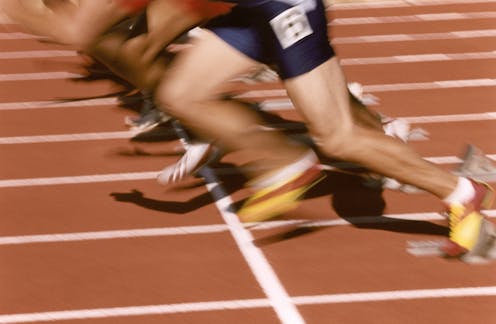Your mighty tendons help you sprint, jump and move – a genetic mutation in one key protein may increase athletic performance
- Written by Hiroshi Asahara, Professor of Molecular Medicine, The Scripps Research Institute

The ability to move is an essential part of daily life. The locomotor, or musculoskeletal, system[1] of the body consists of muscles, bones, tendons, ligaments, joints, cartilage and other connective tissue. Loss of motor function[2] due to disease or injury can result in a lifetime of disability. In a rapidly aging society, maintaining and improving motor function can be a significant challenge for many people.
But there are ways to get around motor failure. As molecular biologists[3] and orthopedic surgeons[4] who study the locomotor system, we believe one key part of it has been underestimated – the tendons.
Tendons[5] are tough tissues that connect muscle to bone. Tendons are what allow kangaroos[6] to jump over 25 feet (7.62 meters) high and run up to 40 mph (64 kph). While their leg muscles are small, the kangaroos’ highly developed and long tendons act like powerful springs. People can also jump higher if they squat down first because their tendons store elastic energy[7] that helps propel them upward.
In our research, we found that the presence of one particular protein in tendons[8] plays a key role in how tendons heal – and a genetic mutation in that protein may also enhance athletic performance.
Tendons connect muscle to bone and are essential to movement.Identifying tendon proteins
Tendon damage can be difficult to heal[9]. Approximately 60% of tendon injuries[10] lead to osteoarthritis[11], a disease resulting from the breakdown of the cartilage in joints that can make movement even more difficult.
Developing treatments for tendon injuries has likewise been challenging. One of the reasons is that the proteins controlling the genes instructing the body to create tendons, called transcription factors[12], had been unknown.
To identify these proteins, we created a catalog[13] of the 1,600 transcription factors in the human body. Based on this catalog, we examined what genes were active in the Achilles tendon of genetically engineered mice and found that a protein called Mkx was a central transcription factor for the health of tendons.
Researchers have long considered tendons to be inert tissue unable to contract like muscles can. But we discovered with our colleague, Ardem Patapoutian[14], the Nobel Prize-holder[15], that one particular protein on the surface of tendon cells, Piezo1, can sense when the tendon is engaging in moderate exercise and stimulate the Mkx transcription factor.
The discovery of Piezo1’s role in the perception of touch won the 2021 Nobel Prize in physiology or medicine.Piezo1 and athletic performance
We then wondered about the role that Piezo1 plays in athletic performance. We were particularly interested in a variant of Piezo1 called E756del, which is found in around a third of people of African descent[16] and thought to play a potential role in how high people can jump[17].
So we genetically engineered mice to produce an equivalent mouse version of Piezo1 E756del proteins throughout their body and then tested their performance[18] on different physical activities, including long jump and running on a treadmill. Surprisingly, we found that mice with E756del proteins were able to jump about 1.6 times farther without training than mice without the E756del proteins. Mice with Piezo1 in their tendons were also able to run about 1.2 times faster than those without Piezo1.
To identify which body part was producing this jumping ability, we then created mice that produced Piezo1 proteins either in their muscles or their tendons. The results were even more surprising: Mice with Piezo1 in their tendons improved in their jumping ability just as well as mice with Piezo1 throughout their entire body. Mice with Piezo1 only in their muscles, however, did not have any improvement in jumping ability.
We then decided to test the role of Piezo1 in human athletic performance. In collaboration with the Athlome Consortium[19], an international athletic genomics organization, we compared the prevalence of the gene that codes for E756del in 91 Olympic-level Jamaican sprinters and 108 people in the general population in Jamaica. We found that 54% of Jamaican sprinters had an active gene for E756del, compared to just approximately 30% of the general population.
Our findings show that changing a single protein, in this case E756del, can play a role in athletic performance. Further research on tendons and other parts of the human motor systems could help improve treatments for musculoskeletal conditions.
References
- ^ locomotor, or musculoskeletal, system (www.betterhealth.vic.gov.au)
- ^ Loss of motor function (www.physio-pedia.com)
- ^ molecular biologists (scholar.google.com)
- ^ orthopedic surgeons (www.researchgate.net)
- ^ Tendons (my.clevelandclinic.org)
- ^ kangaroos (a-z-animals.com)
- ^ store elastic energy (spaniardperformance.com)
- ^ one particular protein in tendons (doi.org)
- ^ difficult to heal (doi.org)
- ^ 60% of tendon injuries (doi.org)
- ^ osteoarthritis (www.cdc.gov)
- ^ transcription factors (www.nature.com)
- ^ created a catalog (www.embrys.jp)
- ^ Ardem Patapoutian (scholar.google.com)
- ^ Nobel Prize-holder (www.nobelprize.org)
- ^ a third of people of African descent (doi.org)
- ^ how high people can jump (doi.org)
- ^ tested their performance (doi.org)
- ^ Athlome Consortium (www.athlomeconsortium.org)
Authors: Hiroshi Asahara, Professor of Molecular Medicine, The Scripps Research Institute

